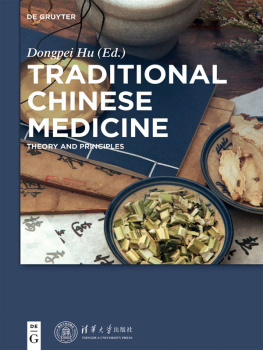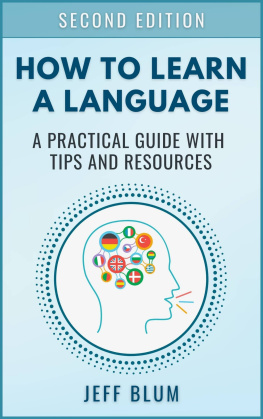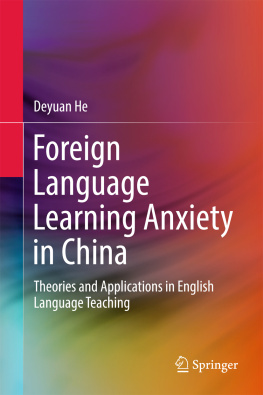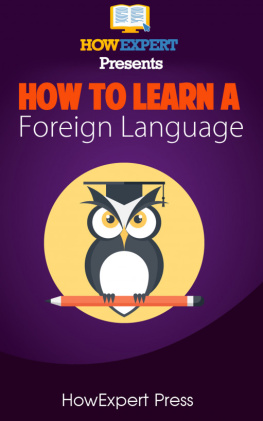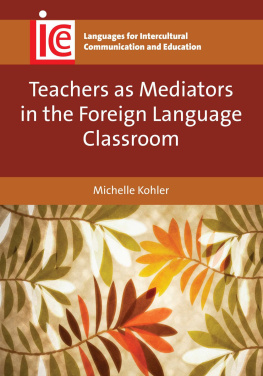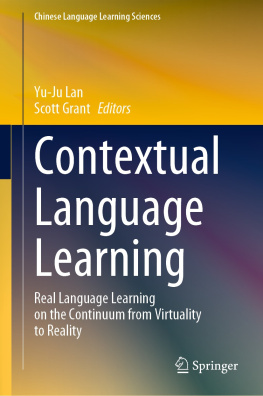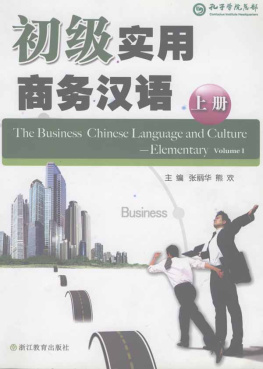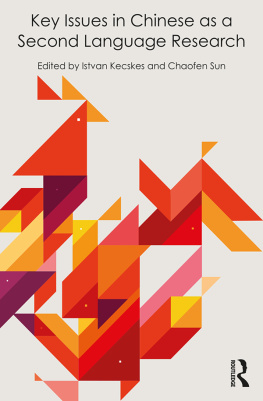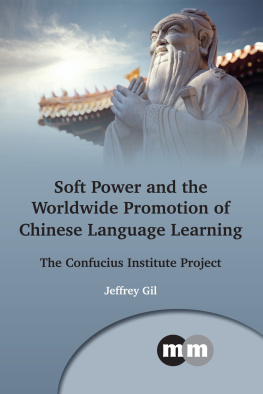Hu - Manual for teaching and learning Chinese as a foreign language
Here you can read online Hu - Manual for teaching and learning Chinese as a foreign language full text of the book (entire story) in english for free. Download pdf and epub, get meaning, cover and reviews about this ebook. City: Array, year: 2018, publisher: Routledge, genre: Children. Description of the work, (preface) as well as reviews are available. Best literature library LitArk.com created for fans of good reading and offers a wide selection of genres:
Romance novel
Science fiction
Adventure
Detective
Science
History
Home and family
Prose
Art
Politics
Computer
Non-fiction
Religion
Business
Children
Humor
Choose a favorite category and find really read worthwhile books. Enjoy immersion in the world of imagination, feel the emotions of the characters or learn something new for yourself, make an fascinating discovery.

Manual for teaching and learning Chinese as a foreign language: summary, description and annotation
We offer to read an annotation, description, summary or preface (depends on what the author of the book "Manual for teaching and learning Chinese as a foreign language" wrote himself). If you haven't found the necessary information about the book — write in the comments, we will try to find it.
Hu: author's other books
Who wrote Manual for teaching and learning Chinese as a foreign language? Find out the surname, the name of the author of the book and a list of all author's works by series.
Manual for teaching and learning Chinese as a foreign language — read online for free the complete book (whole text) full work
Below is the text of the book, divided by pages. System saving the place of the last page read, allows you to conveniently read the book "Manual for teaching and learning Chinese as a foreign language" online for free, without having to search again every time where you left off. Put a bookmark, and you can go to the page where you finished reading at any time.
Font size:
Interval:
Bookmark:

Manual for Teaching and Learning Chinese as a Foreign Language
Written in an extended dictionary format, the Manual for Teaching and Learning Chinese as a Foreign Language aims to cover all key terms related to teaching Chinese as a foreign language.
Each section contains an introduction with language-specific information, and identifies students and teachers common questions, including the capacity of Chinese as a morphologically unmarked language to indicate categories such as tense and mood. Many entries listed in this manual come with an explanation, a commentary, and rich examples.
The Manual for Teaching and Learning Chinese as a Foreign Language appeals to both Chinese as a foreign language (CFL) teachers and students, as well as being the ideal reference for researchers conducting comparative studies of the Chinese and English languages.
Bo Hu is Instructor of Chinese at the Institute for Chinese Studies, University of Oxford, UK.
Routledge Chinese Language Pedagogy
Series editor: Yongcan Liu
Titles in the series
A Guide to Chinese Teaching Materials
Designing, Selecting, Preparing, and Evaluating (forthcoming)
Wei Jin
Interculturality in Chinese Language Teaching and Learning(forthcoming)
Tinghe Jin
Manual for Teaching and Learning Chinese as a Foreign Language
Bo Hu
Teaching and Learning Chinese in Higher Education
Theoretical and Practical Issues
Yang Lu
Technology-Assisted Instruction in Teaching Chinese as a Foreign Language(forthcoming)
Amber Navarre
The Identity of Chinese Heritage Language Learners in a Global Era(forthcoming)
Zhen Li
The Routledge Advanced Language Training Course for K-16 Non-native Chinese Teachers
Hong Gang Jin, Lian Xue, Yusheng Yang and Lan Zhao Zhou
To see a full range of titles, please visit: www.routledge.com/languages/series/RCLP
Manual for Teaching and Learning Chinese as a Foreign Language
Bo Hu

First published 2018
by Routledge
2 Park Square, Milton Park, Abingdon, Oxon OX14 4RN
and by Routledge
711 Third Avenue, New York, NY 10017
Routledge is an imprint of the Taylor & Francis Group, an informa business
2018 Bo Hu
The right of Bo Hu to be identified as author of this work has been asserted by her in accordance with sections 77 and 78 of the Copyright, Designs and Patents Act 1988.
All rights reserved. No part of this book may be reprinted or reproduced or utilised in any form or by any electronic, mechanical, or other means, now known or hereafter invented, including photocopying and recording, or in any information storage or retrieval system, without permission in writing from the publishers.
Trademark notice: Product or corporate names may be trademarks or registered trademarks, and are used only for identification and explanation without intent to infringe.
British Library Cataloguing-in-Publication Data
A catalogue record for this book is available from the British Library
Library of Congress Cataloging-in-Publication Data
Names: Hu, Bo (Language teacher) author.
Title: Manual for teaching and learning Chinese as a foreign language / Bo Hu.
Description: London ; New York : Routledge, [2018] | Series: Routledge Chinese language pedagogy
Identifiers: LCCN 2017055443| ISBN 9781138308398 (hardcover : alk. paper) | ISBN 9781138309302 (softcover : alk. paper) | ISBN 9781315143323 (ebook)
Subjects: LCSH: Chinese languageStudy and teachingForeign speakers. | Chinese languageTextbooks for foreign speakers. | Chinese languageResearch. | AsiaLanguages.
Classification: LCC PL1065 .H776 2018 | DDC 495.186/421dc23
LC record available at https://lccn.loc.gov/2017055443
ISBN: 978-1-138-30839-8 (hbk)
ISBN: 978-1-138-30930-2 (pbk)
ISBN: 978-1-315-14332-3 (ebk)
Typeset in Times New Roman
by Out of House Publishing
Contents
This book serves as a convenient all-purpose reference book for professionals teaching Chinese as well as for learners of Chinese as a foreign language. It adopts a dictionary format, listing terms and points of grammar that are crucial in the teaching and learning of the language. Some entries are given translations only whereas many other entries provide discussion and examples. Certain technical terms are used but explanations and contexts are also provided to make them easily understandable.
This book has four general chapters: Pinyin, Words, Grammar, and Characters. The introduction to each chapter provides language-specific information. For example, the introduction to the chapter on Grammar addresses common questions about the ability of Chinese, as a morphologically unmarked language, to indicate grammatical categories such as tense and mood. The chapter introduction also includes a paragraph discussing some methodological issues involved in teaching and learning the language.
This book also stands out in the following aspects: 1) It discusses the difference between English and Chinese in a way that is relevant to both teaching and learning. For instance, the section Special Sentence Structure features particular structures in Chinese that have never before been collated and given sufficient attention; 2) It also pays greater attention to the nuanced differences between function words sharing a degree of similarity, which cause confusion among learners of Chinese, such as and , and , among others; 3) Various sections of the book touch upon the topic of learning strategies in particular when it comes to learning tones and characters in Chinese.
Finally, this book is the product of many years of experience as a Chinese language teacher. I have written it with both teachers and learners in mind, with an emphasis on clarity and user-friendliness.
Pinyin
Pinyin is a Romanisation of the Chinese language, used for the purpose of helping learners to pronounce characters that appear in textbooks and dictionaries. It has 21 consonants (initials) and 36 vowels or semi-vowels (finals), which combine to form the syllables of Chinese. Each character in Chinese corresponds to a single syllable. A very limited number of Chinese syllables only consist of a final vowel, with no initial consonant(s). These standalone vowels are not contracted with the sounds preceding them. (The lone exception to this is the retroflex er, the use of which is relatively uncommon and mostly limited to accents heard in northern China (see also Pinyin finals retroflex final). It is thus reasonable to state that individual syllables in Chinese are pronounced independently of one another.
Each Pinyin syllable is marked either by one of the four pronounced tones or by the neutral tone. Chinese is one of the few tonal languages spoken around the world. These are languages in which tones play an important role in distinguishing the meaning of words. For example, the syllable wen could mean to smell , as it does when pronounced with a rising tone, or, with a falling tone, to ask ; the meaning of the combined syllables huang dao is ecliptic when the first syllable has a rising tone and the second has a falling tone, but these same syllables mean desert island when pronounced with a flat tone preceding an up-and-down tone. To get a real sense of the importance of tone variations and their limitations in Chinese, one can read the stories sh sh sh sh sh,
Font size:
Interval:
Bookmark:
Similar books «Manual for teaching and learning Chinese as a foreign language»
Look at similar books to Manual for teaching and learning Chinese as a foreign language. We have selected literature similar in name and meaning in the hope of providing readers with more options to find new, interesting, not yet read works.
Discussion, reviews of the book Manual for teaching and learning Chinese as a foreign language and just readers' own opinions. Leave your comments, write what you think about the work, its meaning or the main characters. Specify what exactly you liked and what you didn't like, and why you think so.

